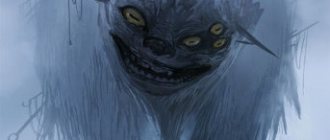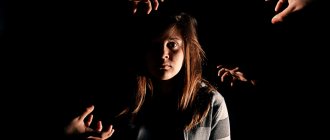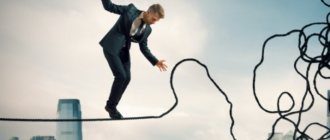Aichmophobia - panic fear of sharp objects (knives, thorns, needles, scalpels, scissors, blades).
This type of phobia is common and is the most understandable and easily explained. Aichmophobia is based on the instinct of self-preservation, which, due to negative life experiences, takes on an exaggerated form.
Fear is always associated with physical or emotional trauma received from contact with sharp, piercing or cutting objects.
The mental disorder is manifested by periodic panic attacks and is not accompanied by a general increase in anxiety. The frequency of seizures depends on the severity of the disease. In particularly severe forms of phobia, attacks can occur daily. In mild forms - once for several months.
The attack of intense fear lasts about 10 minutes. During this period of time, a person’s imagination draws frightening pictures involving sharp objects. During a panic attack, it seems to the patient that he is in mortal danger; it is impossible to convince him otherwise.
An episode of uncontrollable fear can be provoked either by a real threat to health or life, or by nervous exhaustion of a person.
Another feature of aichmophobia is that women suffer from it more often , although injuries from sharp objects occur more often among men. The phobia usually appears between the ages of 20 and 50.
Items of greatest concern:
- knives and scissors,
- sharp cutlery,
- push pins and paper clips,
- sewing needles and pins,
- shards of broken glass,
- steel arms,
- pencils,
- razor blade,
- some gardening tools,
- the sharp end of the umbrella,
- pointed carpentry and construction supplies and materials,
- sharp corners.
The most common object of fear is the knife.
Causes of aichmophobia
A phobia can arise either after being injured or injured, or after a very strong experience for one’s life. Main causes of phobia:
- Serious domestic injury. In childhood, emotional distress can be aggravated by the fact that a parent was not with the child at the time of the accident.
- The man was the victim of an attack; the attacker threatened him with a sharp object.
- Stereotypes ingrained in childhood. Sharp household items are something that children are always warned against.
- Watching a horror movie.
- A person witnessed a crime or accident.
- A close friend or relative was injured in a situation involving sharp objects.
- Work injury.
- Failed suicide attempt.
Diagnostics
It is not difficult to identify a phobia of sharp objects; it is an isolated form of the disease, that is, it has only one group of similar objects. If you are constantly afraid of the sight of scissors or the idea of a knife, then you are clearly suffering from this disease.
Diagnosing the cause of a phobia is much more difficult. To do this, you need to contact a psychologist. During the conversation, the specialist will study the characteristics of the client’s life, his history of childhood and development. The psychologist will quickly and accurately determine what the trigger mechanism was.
Aichmophobia test
There is no thematic test to identify aichmophobia. The subject of fear is already clear to the psychologist and the patient. But to determine the severity of a phobia, tests are used to determine the level of anxiety and to identify phobias as such. For example, you can use the Zang scale or the Spielberg-Hanin test.
Behavioral characteristics of a person suffering from aichmophobia
- When eating, a person suffering from a phobia avoids sharp cutlery, including plastic ones.
- Aichmophobe has a negative attitude towards collecting edged weapons and may criticize a person who is passionate about this hobby.
- The patient often complains about how difficult it is to live if there are so many sharp objects nearby.
- A person tries to clear the apartment of all things that cause fear, even if their absence will greatly complicate life.
- The person suffering from the disorder avoids any physical contact with sharp objects.
What are children afraid of at different ages?
Up to 6 months. Children at this age are frightened by unfamiliar sounds, bright lights, loss of support, and objects approaching too quickly. What to do? Avoid all this. For example, turn on the light gradually.
From 8 months to 1.5 years. Fear of strangers arises. Often at this age, parents organize christenings or, for example, invite guests for the first time. Before, they waited until the child got stronger. And the baby, who at four months old willingly sat in his grandmother’s arms, now recognizes only his mother and father, and tries to crawl away from the rest or cries deafeningly. Normally, this condition lasts up to one and a half years, and then goes away on its own. For some - a little faster, for others - later.
This is a mechanism laid down by nature. Children at this age are already beginning to move independently. And so that they do not get into trouble in the outside world, they are afraid of losing their mother. In addition, infants cannot yet retain their mother’s image in their memory when she is not around. Therefore, even if she goes into the next room, it is a disaster for them - it seems that the dearest person has disappeared from their life. As children grow older, they keep the image of their mother in their memory, and this fear weakens.
2 years. The child begins to walk and explore the world. He develops fears associated with movement. He begins to be afraid of heights, dogs, moving cars, fire - what he sees around him.
3 years. A person first separates himself from others at this age. His fears change. Now he is afraid of the consequences of his actions. Kids are afraid that they will be punished or that no attention will be paid to them.
5 years and older. This is the most “scary” age. During this period, the child has the maximum number of fears. Can reach up to 20 at a time. And that's absolutely normal!
In preschoolers, their inner world becomes richer and their imagination develops. An impressionable child can imagine all the events of the world around him in such a way that he will be afraid. Intellectually he is already capable of this.
A preschooler may be afraid of the dark (or rather, of what lurks in it), open spaces, dangerous objects, brownies, monsters, ghosts... Anything. Children will forgive most fears without any problems. But there is a small percentage of preschoolers in whom they transform into more serious disorders. We'll talk about this later.
Katerina Murashova: Don’t wait a month to tell your child about dad’s death
Another important point. Among other fears, at the age of 5–6 years, a child first develops a fear of death. Until this moment, the little person does not really understand what it is, and does not think that one of his loved ones may die. Often parents turn to a psychologist when a child is afraid that he or his parents will die.
From 7 to 12 years. Fears are related to self-esteem. Younger schoolchildren are more afraid of negative assessments from adults - parents (“mom will scold for a bad grade”) or teachers (“I’m afraid of Marya Ivanovna, she’s strict”). Teenagers are concerned about the opinions of their peers.
From 16 and older. Youthful fears are related to the future. They are afraid of the Unified State Exam, choosing a profession, and adult life. Today's teenagers are often called the "snowflake generation." They were born after the 90s and zeros. Their parents tried to give them a lot, because in childhood they did not receive a minimum of life problems that train people and help them cope with difficulties in the future. It is more difficult for such children to resolve issues related to choosing a life path.
Symptoms of aichmophobia and diagnosis
In certain everyday situations, fear of sharp, piercing or cutting objects can arise in any person. But the presence of obsessive fear can be assumed only if at least four signs are noted, listed below:
- heat,
- increased sweating,
- sudden change in heart rate,
- inability to breathe,
- trembling in the limbs,
- heaviness in the abdomen and legs,
- chest pain,
- stabbing sensations in fingers,
- state of stupor,
- inability to look away or blink,
- drowsiness or increased activity,
- hearing loss.
Signs
The symptoms of aichmophobia are, in principle, the same as those of other phobias. This is dry mouth, rapid heartbeat, and in some cases pain in the heart, which causes thoughts of imminent death, and only worsens general well-being.
Your arms and legs may tremble, numbness and sweating will appear. The breathing process becomes more difficult due to the fact that breaths are frequent and short, leading to oxygen oversaturation. Why, it seems that, on the contrary, it is sorely lacking.
In such cases, you should simply breathe into a paper bag or into your palms. By inhaling the carbon dioxide released during exhalation, we stabilize the level of oxygen in the blood, and therefore the condition.
There are also stomach problems, in addition to acute colic, vomiting and diarrhea can make themselves felt. Due to changes in pressure, a person, frightened by a sharp object, may lose consciousness and control over himself, that is, “fall” into hysterics and run around screaming for help, cry and try to hide in any secluded place.
For example, in a closet or under a table. What from the outside looks like a manifestation of complete madness, when an adult, seeing a pencil in the hands of his interlocutor, begs for mercy and tries to jump out of the window.
Consequences of Aichmophobia
In everyday life, a person is constantly surrounded by objects that can cause fear in an Aichmophobe. The inability to cope with negative emotions forces a person to give up many types of work, hobbies and professional activities. Sharp household items do not allow the patient to feel comfortable even at home .
The desire to get rid of everything that causes anxiety complicates life not only for the person suffering from a phobia, but also for his family members. It is impossible to conduct everyday life without using cutting or piercing objects.
The behavior of a person who tries to cope with the household without using knives, scissors and needles may seem inadequate to others. The more severe the form of the disease becomes, the more a person’s social connections are broken.
What does it represent?
Aichmophobia is translated from the Greek “aichme” as “edge” and, accordingly, “phobos” as fear. There is another name, but it is not so often used - oxyphobia.
This fear is so irrational that a person in severe cases cannot even use pencils and pens in everyday life.
Now imagine how he will manage in everyday life, cook food, do cleaning and just go out into the street, where there are objects everywhere that can easily get hurt?
No amount of persuasion or serious arguments about the absurdity of fear will influence him. The very sight of something stabbing causes a lot of suffering, and trying to touch them completely aggravates the condition.
The only desire will be to quickly escape from the place where the danger is located.
Treatment of aichmophobia
Fixed fear does not go away without treatment, so the patient definitely needs the help of a professional. Aichmophobia is not always an independent disorder.
If a person has been the victim of intentional violence, been seriously injured or lost a limb in an accident, survived a suicide attempt, or lost a close relative in these situations, Aichmophobia may be a symptom of serious post-traumatic stress disorder that requires rehabilitation.
Before starting treatment, the specialist determines which disease needs to be treated. Since Aichmophobia is associated with defensive behavior, treatment is not aimed at completely ridding the patient of fear, but at reducing anxiety to the level of rational caution.
Psychotherapeutic methods for treating aichmophobia:
- psychological modeling method,
- hypnosis,
- relaxation,
- art therapy,
- cognitive behavioral psychotherapy,
- method of systematic desensitization.
Psychotherapy usually produces lasting positive results.
Features of drug treatment of aichmophobia:
Medications are prescribed only for severe forms of the disorder, since too frequent panic attacks do not allow the main course of treatment. After the frequency of attacks has decreased and the desired treatment result has been achieved, medications are discontinued.
If the disorder is particularly severe, the patient may experience daily panic attacks and lose consciousness. In such cases, the aichmophobe is sent to a hospital, where, under the supervision of a doctor, he receives maximum doses of medications.
Then maintenance therapy with psychopharmacological drugs is carried out. When the expected results are achieved, medications are gradually discontinued.
Ways to combat the fear of sharp objects
Aichmophobia, in comparison with some other fears, is easily explained and has specific causes and symptoms. But each case remains individual.
Therapy should begin as soon as the realization comes that the fear of sharp objects is present not only as an instinct of self-preservation. The more time passes from the onset of the development of a phobia, the longer and more difficult it will be to get rid of it.
Self-correction is possible at an early stage. Some techniques are available to the client to help get rid of obsessive fear.
Self help
You need to learn to relax when you see a source of stress, be able to switch your attention in time and look away or remove an object from your eyes. These techniques are available to aichmophobes who have a stable nervous system and the strength of the manifestation of fear is low. Communication with those who suffer from such a phobia helps: openness and frank conversations sometimes help to identify the essence of the problem, understand and get rid of fear. Gradually, Aichmophobia will disappear.
Problem Definition
The first step towards recovery from aichmophobia is to write a detailed description of a typical case of panic. What happens to the nervous system, under what conditions, what does not cause fear. You need to pay attention to:
- appearance of the object: whether any sharp things trigger the phobia, or just a group. Each phobia is multifaceted in its manifestations: in the case of aichmophobia, a person, for example, can calmly use a knife or fork, but be horrified by the sight of pushpins. Or, without exception, all objects with a sharp edge cause anxiety; at the sight of glass fragments it will be only mild discomfort, and at the sight of a knife - panic, tachycardia and suffocation. Perhaps the cause of a panic attack is only a specific item, for example, a knife from a collection;
- strength of manifestation: slight trembling, hostility, attempts to remove an object from the eyes, or a feeling of imminent death, clouding of consciousness;
- external factors: whether the strength of manifestation is affected by lighting, temperature, the presence or absence of other people in the room, street conditions.
A detailed description can be drawn up by the client himself or together with a specialist psychologist.
Gradual rapprochement
A method of cognitive behavioral therapy based on a combination of relaxation techniques and gradual rapprochement with the object that causes fear. It is better to carry out such therapy under the supervision of an experienced psychotherapist. He will teach you how to relax correctly and suggest techniques that will help you cope with panic. The number of sessions depends on the strength of the manifestation and how deep the fear sits in the mind.
Hypnotherapy
Psychologist-hypnologist Nikita Valerievich Baturin believes that getting rid of a phobia using hypnosis is the most gentle and fastest way. Based on my experience working with aichmophobes, the best results are achieved with this treatment. It is not suitable for everyone, and is not justified in all cases, so a consultation is required before hypnotherapy.
There is no danger in a state of hypnosis: the hypnologist acts only on that part of the consciousness that is responsible for the occurrence of panic attacks.
Art therapy
The method is used independently or in combination with others. Materials: paper, bright markers, paints. The patient draws according to the instructions of the art therapist, relieving the subconscious of unnecessary anxiety.
Traditional medicine
Medicines that are sedative and affect consciousness can only be used in combination with previous methods and only under the supervision of a specialist. If an Aichmophobe is prescribed drug therapy, you should not ignore the prescription and rely only on the possibilities of cognitive behavioral or hypnotherapy. The more complete treatment is received, the faster the patient gets rid of the fear of sharp objects.
Aichmophobia is a fear that prevents you from living life to the fullest. Sharp objects are found everywhere; it is impossible to eliminate the source of stress completely. To prevent manifestations of a phobia from affecting relationships with others, it is important to recognize the problem in time and begin therapy as early as possible. Interaction with a psychologist, hypnologist, or art therapist will help get rid of aichmophobia in a few sessions, returning a person to a full life.
Self-help for Aichmophobia
With aichmophobia, self-medication can only be allowed as an addition to the main course of treatment. You can resort to the following self-help methods:
- Attention management. The patient should learn not to focus his attention on the object of fear. If there are signs of anxiety, you need to shift your gaze to a more pleasant object to contemplate.
- Relaxation. It is ideal if a person knows special relaxation techniques. However, you can also resort to simpler methods of relaxation: listening to pleasant music, taking a relaxing bath, etc.
- Communication with aichmophobes. Discussing a common problem sometimes helps you understand the true reason for your irrational fear.
What does an neglected phobia lead to?
Without treatment, the phobia will progress, and the list of frightening objects will expand.
Sooner or later, the patient will not be able to leave the house, and perhaps the house itself will be driven into panic. Constant tension is dangerous due to exhaustion, the development of secondary disorders, disorientation, and inappropriate actions. As the phobia develops, the subconscious endows huge objects with new qualities. At this stage, the thought of animated statues, pursuing planes and trains appears. Large objects come to the patient in dreams, which leads to insomnia or conscious sleep deprivation. It further aggravates the course of the disease, new fears, delusions, and hallucinations appear.











